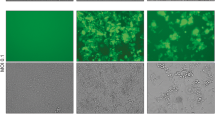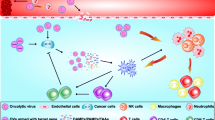Abstract
Background
Many types of oncolytic viruses (OVs) were enrolled in clinical trials. Recently, an OV named Talimogene laherparepvec approved for the treatment of melanoma. This achievement highlighted the clinical application of OVs. Scientists focus on using these anticancer agents in combination with the current or/and new anticancer chemotherapeutics. They aim to increase the oncolytic effect of a new approach for the treatment of cancer cells.
Objectives
The present study aimed to assess the anticancer impacts of ReoT3D, irinotecan (CPT-11), and napabucasin (BBI608) against murine colorectal cancer cells (CT26). They are assessed alone and in combination with each other.
Methods
Here, oncolytic reovirus was propagated and titrated. Then MTT assay was carried out to assess the toxicity of this OV and chemotherapeutics effect on CT26 cells. The anticancer effects of ReoT3D, CPT-11, and BBI608, alone and simultaneously, on CT26 cell line, were assessed by the induction of apoptosis, cell cycle arrest, colony-forming, migration, and real-time PCR experiments.
Results
Alone treatment with ReoT3D, CPT-11, and BBI608 led to effectively inducing of apoptosis, cell cycle arrest, and apoptotic genes expression level and significantly reduce of colony-forming, migration, and anti-apoptotic genes expression rate. Importantly, the maximum anticancer effect against CT26 cell line was seen upon combination ReoT3D, CPT-11, and BBI608 treatment.
Conclusion
The present study highlights that combination of ReoT3D, CPT-11, and BBI560 showed synergistic anticancer activity against CT26 cell line. This modality might be considered as a new approach against colorectal cancer (CRC) in the in vivo and clinical trial investigations.
Graphical abstract







Similar content being viewed by others
Explore related subjects
Discover the latest articles and news from researchers in related subjects, suggested using machine learning.Data availability
Available upon the request.
Code availability
Not applicable.
References
Cabasag CJ, Arnold M, Butler J, Inoue M, Trabert B, Webb PM, et al. The influence of birth cohort and calendar period on global trends in ovarian cancer incidence. Int J Cancer. 2020;146(3):749–58.
Siegel RL, Miller KD, Fedewa SA, Ahnen DJ, Meester RG, Barzi A, et al. Colorectal cancer statistics, 2017. CA Cancer J Clin. 2017;67(3):177–93.
Geng F, Wang Z, Yin H, Yu J, Cao B. Molecular targeted drugs and treatment of colorectal cancer: recent progress and future perspectives. Cancer Biother Radiopharm. 2017;32(5):149–60.
Lawler SE, Speranza M-C, Cho C-F, Chiocca EA. Oncolytic viruses in cancer treatment: a review. JAMA Oncol. 2017;3(6):841–9.
Food U, Administration D. FDA approves first-of-its-kind product for the treatment of melanoma. Silver Spring, MD 2015:611–619.
Chiocca EA, Rabkin SD. Oncolytic viruses and their application to cancer immunotherapy. Cancer Immunol Res. 2014;2(4):295–300.
Goodarzi Z, Soleimanjahi H, Arefian E, Saberfar E. The effect of bovine rotavirus and its nonstructural protein 4 on ER stress-mediated apoptosis in HeLa and HT-29 cells. Tumour Biol. 2016;37(3):3155–61.
Fukuhara H, Ino Y, Todo T. Oncolytic virus therapy: a new era of cancer treatment at dawn. Cancer Sci. 2016;107(10):1373–9.
Thirukkumaran C, Shi Z-Q, Thirukkumaran P, Luider J, Kopciuk K, Spurrell J, et al. PUMA and NF-kB are cell signaling predictors of reovirus oncolysis of breast cancer. PLoS One. 2017;12(1):e0168233.
Phillips MB, Stuart JD, Stewart RMR, Berry JT, Mainou BA, Boehme KW. Current understanding of reovirus oncolysis mechanisms. Oncolytic Virother. 2018;7:53–63.
Marcato P, Shmulevitz M, Lee PW. Connecting reovirus oncolysis and Ras signaling. Cell Cycle. 2005;4(4):556.
Drerup JM, Liu Y, Padron AS, Murthy K, Hurez V, Zhang B, et al. Immunotherapy for ovarian cancer. Curr Treat Options in Oncol. 2015;16(1):1.
Smakman N, van den Wollenberg DJ, Rinkes IHB, Hoeben RC, Kranenburg O. Sensitization to apoptosis underlies KrasD12-dependent oncolysis of murine C26 colorectal carcinoma cells by reovirus T3D. J Virol. 2005;79(23):14981–5.
Zhao X, Chester C, Rajasekaran N, He Z, Kohrt HE. Strategic combinations: the future of oncolytic virotherapy with reovirus. Mol Cancer Ther. 2016;15(5):767–73.
Villalona-Calero MA, Lam E, Otterson GA, Zhao W, Timmons M, Subramaniam D, et al. Oncolytic reovirus in combination with chemotherapy in metastatic or recurrent non–small cell lung cancer patients with K RAS-activated tumors. Cancer. 2016;122(6):875–83.
Phan M, Watson MF, Alain T, Diallo J-S. Oncolytic viruses on drugs: achieving higher therapeutic efficacy. ACS Infect Dis. 2018;4(10):1448–67.
Xu Y, Villalona-Calero M. Irinotecan: mechanisms of tumor resistance and novel strategies for modulating its activity. Ann Oncol. 2002;13(12):1841–51.
Prewett MC, Hooper AT, Bassi R, Ellis LM, Waksal HW, Hicklin DJ. Enhanced antitumor activity of anti-epidermal growth factor receptor monoclonal antibody IMC-C225 in combination with irinotecan (CPT-11) against human colorectal tumor xenografts. Clin Cancer Res. 2002;8(5):994–1003.
Hubbard JM, Grothey A. Napabucasin: an update on the first-in-class cancer stemness inhibitor. Drugs. 2017;77(10):1091–103.
Banijamali RS, Soleimanjahi H, Soudi S, Karimi H, Abdoli A, Seyed KS, et al. Kinetics of Oncolytic Reovirus T3D replication and growth pattern in Mesenchymal stem cells. Cell J. 2020;22(3):283–92.
Smith RE, Zweerink H, Joklik WK. Polypeptide components of virions, top component and cores of reovirus type 3. Virology. 1969;39(4):791–810.
Van Engeland M, Nieland LJ, Ramaekers FC, Schutte B, Reutelingsperger CP. Annexin V-affinity assay: a review on an apoptosis detection system based on phosphatidylserine exposure. Cytometry. 1998;31(1):1–9.
Zhang G, Gurtu V, Kain SR, Yan G. Early detection of apoptosis using a fluorescent conjugate of annexin V. Biotechniques. 1997;23(3):525–31.
Comins C, Heinemann L, Harrington K, Melcher A, De Bono J, Pandha H. Reovirus: viral therapy for cancer ‘as nature intended’. Clin Oncol. 2008;20(7):548–54.
Liu L-X, Zhang W-H, Jiang H-C. Current treatment for liver metastases from colorectal cancer. World J Gastroenterol. 2003;9(2):193–200.
Pandha HS, Heinemann L, Simpson GR, Melcher A, Prestwich R, Errington F, et al. Synergistic effects of oncolytic reovirus and cisplatin chemotherapy in murine malignant melanoma. Clin Cancer Res. 2009;15(19):6158–66.
Maitra R, Seetharam R, Tesfa L, Augustine TA, Klampfer L, Coffey MC, et al. Oncolytic reovirus preferentially induces apoptosis in KRAS mutant colorectal cancer cells, and synergizes with irinotecan. Oncotarget. 2014;5(9):2807–19.
Igase M, Hwang CC, Kambayashi S, Kubo M, Coffey M, Miyama TS, et al. Oncolytic reovirus synergizes with chemotherapeutic agents to promote cell death in canine mammary gland tumor. Can J Vet Res. 2016;80(1):21–31.
Mahalingam D, Goel S, Aparo S, Patel Arora S, Noronha N, Tran H, et al. A phase II study of pelareorep (REOLYSIN®) in combination with gemcitabine for patients with advanced pancreatic adenocarcinoma. Cancers. 2018;10(6):160.
Comins C, Spicer J, Protheroe A, Roulstone V, Twigger K, White CM, et al. REO-10: a phase I study of intravenous reovirus and docetaxel in patients with advanced cancer. Clin Cancer Res. 2010;16(22):5564–72.
Mahalingam D, Wilkinson GA, Eng KH, Fields P, Raber P, Moseley JL, et al. Pembrolizumab in combination with the Oncolytic virus Pelareorep and chemotherapy in patients with advanced pancreatic adenocarcinoma: a phase Ib study. Clin Cancer Res. 2020;26(1):71–81.
Seetharam RN, Coffey MC, Klampfer L, Mariadason J, Goel S. The addition of Reolysin, an oncolytic reovirus, to irinotecan shows synergistic anticancer activity in colorectal cancer cell lines. AACR; 2010.
Bahrami A, Amerizadeh F, ShahidSales S, Khazaei M, Ghayour-Mobarhan M, Sadeghnia HR, et al. Therapeutic potential of targeting Wnt/β-catenin pathway in treatment of colorectal cancer: rational and progress. J Cell Biochem. 2017;118(8):1979–83.
Fuchs C, Mitchell EP, Hoff PM. Irinotecan in the treatment of colorectal cancer. Cancer Treat Rev. 2006;32(7):491–503.
Beckham JD, Tuttle KD, Tyler KL. Caspase-3 activation is required for reovirus-induced encephalitis in vivo. J Neuro-Oncol. 2010;16(4):306–17.
Berger AK, Danthi P. Reovirus activates a caspase-independent cell death pathway. MBio. 2013;4(3):e00178–13.
Banijamali RS, Soleimanjahi H, Soudi S, Karimi H, Abdoli A, Khorrami SMS, et al. Kinetics of Oncolytic Reovirus T3D replication and growth pattern in Mesenchymal stem cells. Cell J. 2020;22(3):283–92.
Tian J, Zhang X, Wu H, Liu C, Li Z, Hu X, et al. Blocking the PI3K/AKT pathway enhances mammalian reovirus replication by repressing IFN-stimulated genes. Front Microbiol. 2015;6:886.
Zhang Y, Jin Z, Zhou H, Ou X, Xu Y, Li H, et al. Suppression of prostate cancer progression by cancer cell stemness inhibitor napabucasin. Cancer Med. 2016;5(6):1251–8.
Siddiquee KAZ, Turkson J. STAT3 as a target for inducing apoptosis in solid and hematological tumors. Cell Res. 2008;18(2):254–67.
Bhonde M, Hanski M, Notter M, Gillissen B, Daniel P, Zeitz M, et al. Equivalent effect of DNA damage-induced apoptotic cell death or long-term cell cycle arrest on colon carcinoma cell proliferation and tumour growth. Oncogene. 2006;25(2):165–75.
Bi S, Chen K, Feng L, Fu G, Yang Q, Deng M, et al. Napabucasin (BBI608) eliminate AML cells in vitro and in vivo via inhibition of Stat3 pathway and induction of DNA damage. Eur J Pharmacol. 2019;855:252–61.
Poggioli GJ, Keefer C, Connolly JL, Dermody TS, Tyler KL. Reovirus-induced G2/M cell cycle arrest requires ς1s and occurs in the absence of apoptosis. J Virol. 2000;74(20):9562–70.
Twigger K, Vidal L, White CL, De Bono JS, Bhide S, Coffey M, et al. Enhanced in vitro and in vivo cytotoxicity of combined reovirus and radiotherapy. Clin Cancer Res. 2008;14(3):912–23.
Kajstura M, Halicka HD, Pryjma J, Darzynkiewicz Z. Discontinuous fragmentation of nuclear DNA during apoptosis revealed by discrete “sub-G1” peaks on DNA content histograms. Cytometry Part A. 2007;71(3):125–31.
Acknowledgements
We thank deputy of research, Tarbiat Modares University and National Institute for Medical Research Development (NIMAD) for financial supports.
Funding
This work was funded by of Tarbiat Modares University, Faculty of Medical Sciences (grant number: Med-76,015) and partially funded by National Institute for Medical Research Development (NIMAD) (grant number: 957970).
Author information
Authors and Affiliations
Contributions
AB has done all experiments, data collection & analysis and also wrote the original draft of the manuscript. HS has designed the work plan, supervised the whole study and edited the original draft. MS and EA were advisers for the present study that has done bioinformatics works and designed primers for the molecular experiment. All authors read and approved the final manuscript.
Corresponding author
Ethics declarations
Conflict of interest
The authors declare that they have no competing interests.
Additional information
Publisher’s note
Springer Nature remains neutral with regard to jurisdictional claims in published maps and institutional affiliations.
Rights and permissions
About this article
Cite this article
Babaei, A., Soleimanjahi, H., Soleimani, M. et al. The synergistic anticancer effects of ReoT3D, CPT-11, and BBI608 on murine colorectal cancer cells. DARU J Pharm Sci 28, 555–565 (2020). https://doi.org/10.1007/s40199-020-00361-w
Received:
Accepted:
Published:
Issue Date:
DOI: https://doi.org/10.1007/s40199-020-00361-w
Keywords
Profiles
- Abouzar Babaei View author profile
- Ehsan Arefian View author profile




